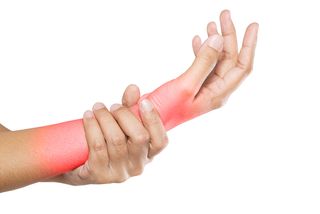Too Much Tech Tied to Carpal Tunnel Syndrome

College students who are glued to their devices may show early signs of developing the painful condition carpal tunnel syndrome, a new study suggests.
Researchers found that young adults who spent an average of 9 hours a day using mobile phones, tablets, gaming consoles and computers reported more pain in their wrists and hands than their peers who spent less time each day using electronic devices. The findings were published online Wednesday (June 21) in the journal Muscle & Nerve.
Carpal tunnel syndrome is a nerve-related condition that causes numbness, tingling and pain in the palm of the hand and wrist. It occurs when there is swelling in a narrow passageway in the wrist known as the carpal tunnel, which puts pressure on the median nerve, a major nerve in the hand. [9 Odd Ways Your Tech Devices May Injure You]
Students in the study who used their devices intensively had changes in both the size and shape of the median nerve, and changes in a ligament called the transverse carpal ligament, the study found. These changes closely mirror the symptoms of people with carpal tunnel syndrome, said study author Peter White, an assistant professor of health technology and informatics at the Hong Kong Polytechnic University.
This means that intensive users may be at greater risk of developing carpal tunnel syndrome, White told Live Science.
In the new study, the researchers analyzed data collected from 48 college students, ages 18 to 25. Besides completing a questionnaire describing how much time they spent using electronic devices in the past year, participants also reported whether they had any pain or discomfort from using these devices.
The researchers defined "intensive" users as those who said they used their electronic devices for at least 5 hours a day. Half of the participants fell into this group. When the researchers calculated how much time these students actually spent using their devices, they found the average was about 9 hours a day. Those who were not intensive users spent about 3 hours a day, on average, using their devices.
Sign up for the Live Science daily newsletter now
Get the world’s most fascinating discoveries delivered straight to your inbox.
About 92 percent of intensive users complained of pain or discomfort in their hands or wrists, but only 25 percent of less frequent users experienced pain, according to the findings.
Experts have been concerned that young people's use of devices could bring on carpal tunnel syndrome, but so far, most studies that have looked at this have focused on smartphone use, the researchers wrote in their study. In the new study, the researchers looked at young adult's use of a slew of devices, and used ultrasounds to spot any problems within the hands at an early stage to get a better idea of the problem. [11 Odd and Intriguing Smart Home Technologies]
The researchers noted that their study was relatively small and included a relatively homogeneous group of participants; all were college students in Hong Kong. Further studies are needed to confirm the results, the researchers said.
Prevention tips
Physical exams and ultrasound imaging of the hands and wrists showed that men and women who logged excessive hours on their electronic devices had median nerves that were swollen and flattened. This can lead to uncomfortable symptoms.
In addition, frequent users had transverse carpal ligaments that were thicker and showed signs of bowing. This may indicate an increase in pressure inside the carpal tunnel and subsequent compression, or squeezing, of the median nerve, White said.
All that swiping, tapping, clicking, scrolling and pressing of game buttons led to pain not only in the hands and wrists of device enthusiasts, but also in other places on their bodies, including the shoulders, necks, upper and lower backs, and elbows, the study found.
Texting, playing games, typing and browsing the internet all involve repetitive movements, and when these movements are done for long periods of time, they can cause injuries, White said.
Young people are avid users of electronic devices. In fact, in one of his previous studies, White said that out of 500 college students surveyed, only 10 percent reported they used these handheld devices for less than 5 hours a day.
Given the increasing and extended use of electronic devices among many age groups, White offered the following tips to help prevent carpal tunnel syndrome.
- Keep wrists flat. Maintaining the wrist in a straight position can reduce stress on the median nerve, White said.
- Pay attention to form and posture. Loosen up tight grips on gaming devices and avoid applying too much force when typing. Avoid keeping the thumb and fingers in a flexed position for long periods of time. This advice is especially important when using only a single hand on a device, White said.
- Take frequent breaks. Build in regular rest periods to gently stretch out your hands (and the rest of your body) and give them a break from constant activity, White said. He recommended taking a 5-minute break for every 30 minutes of device use.
Originally published on Live Science.
Cari Nierenberg has been writing about health and wellness topics for online news outlets and print publications for more than two decades. Her work has been published by Live Science, The Washington Post, WebMD, Scientific American, among others. She has a Bachelor of Science degree in nutrition from Cornell University and a Master of Science degree in Nutrition and Communication from Boston University.

